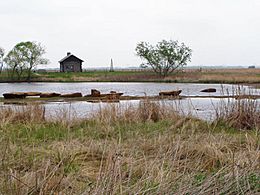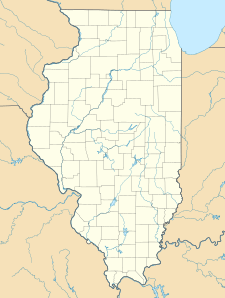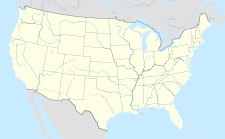Goose Lake Prairie State Natural Area facts for kids
Quick facts for kids Goose Lake Prairie State Natural Area |
|
|---|---|

Cragg Cabin at Goose Lake Prairie
|
|
| Location | Grundy County, Illinois, U.S. |
| Nearest city | Morris, Illinois |
| Area | 2,537 acres (1,027 ha) |
| Governing body | Illinois Department of Natural Resources |
Goose Lake Prairie State Natural Area is a huge park in Illinois, covering about 2,537-acre (1,027 ha). More than half of this park is a special tallgrass prairie. It's protected as an Illinois Nature Preserve. You can find it in Grundy County, close to Morris. It's about 50 miles (80 km) southwest of Chicago.
Contents
What is Goose Lake Prairie?
A Special Landscape from the Ice Age
Long ago, after the last ice age (called the Wisconsin glaciation), this area was flat and wet. It was covered in sand and silt left behind by melting glaciers. The Des Plaines River and Kankakee River meet nearby to form the Illinois River.
Home to Many Animals
Before people changed it, the Goose Lake area was a stable wetland. It had lots of prairie grass around a shallow lake called Goose Lake. This region is part of a special area where forests and grasslands meet.
The Goose Lake area was always a great place for hunting and fishing. It was home to geese, ducks, and other water birds. There were also many kinds of fish and shellfish. Animals like beavers and muskrats, who love wet places, also lived here.
History of the Prairie
Early Settlers and Clay Digging
The land around Goose Lake was very rich for growing crops. But it was also very wet, which made it hard to farm. So, a different future awaited much of this land.
The wet soil under and near Goose Lake had a lot of clay. Starting in the 1820s, settlers began digging up this sticky clay. Some of these settlers were skilled potters. They would bake the clay in hot ovens to make earthenware pots and dishes. These were used for farms and homes.
The potters' village was called Jugtown. Even today, the road to the park's visitor center is called Jugtown Road. Some old Jugtown pottery pieces have been saved by collectors. You can still see some of the large clay pits today. Early settlers also dug ditches to drain parts of the wet prairie. This made the land good for pastures, where cattle could graze.
The Disappearing Lake
In 1890, local farmers worked together to drain Goose Lake. They formed a drainage district to do this. The lake, which was a main feature of the area, disappeared. It was replaced by damp farmland and wet pastures.
However, the drainage was not a complete success. If it had worked perfectly, the remaining patches of prairie would have been plowed under. Today, the park's Marsh Loop Trail goes over part of where the vanished lake used to be.
Mining for Coal
Underneath the clay, there were thin layers of coal. Farmers and potters dug this coal for their own use from the beginning. In the late 1800s, more coal was mined to fuel the growing city of Chicago. The main Santa Fe Railroad line was built next to the prairie. Mines built smaller tracks to carry coal to customers.
Large-scale strip mining with big machines started in 1928. The miners left piles of waste rock, called tailings, in the southern part of the prairie. This changed the landscape even more.
Power Plants and a New Lake
After World War II, two big power plants were built nearby. One was the oil-burning Collins Station. The other was the nuclear-powered Dresden Nuclear Power Plant, built in 1960.
The Collins plant was built with a huge 2,000-acre (810 ha) artificial pond. This pond, called Heidecke Lake, was dug to cool the power plant. Today, Heidecke Lake forms much of the northern border of Goose Lake Prairie. It's interesting how one lake (Goose Lake) was destroyed, and then another (Heidecke Lake) was created by people.
Goose Lake Prairie Today
Protecting the Prairie
The state of Illinois bought the first 250 acres (100 ha) of Goose Lake for nature protection in 1969. More land was added later, creating the Goose Lake Prairie State Natural Area we see today.
The remaining parts of the tallgrass prairie had been greatly changed by people over 150 years. But now, park managers are actively working to restore these areas. They are helping them become a healthy, natural grassland again.
In 1998, two places in the park were added to the National Register of Historic Places. These were the White and Company's Goose Lake Stoneware Manufactury and White and Company's Goose Lake Tile Works.
Exploring the Prairie
Unlike many state parks in Illinois, Goose Lake Prairie is not mainly for hunting. Visitors are encouraged to enjoy the tallgrass prairie ecosystem. This area is full of tall grasses like big bluestem, Indian grass, and switchgrass. You can also see beautiful flowering plants called forbs. These include compass plants, coneflowers, goldenrod, shooting stars, and violets.
Park workers and managers keep up a seven-mile network of trails. You can walk these trails throughout the park. Some parts of the old grassland have grass blades that grow up to eight feet tall!
Wildlife and Rare Insects
The patches of old-growth tallgrass prairie are like safe homes for many species. These animals and plants can't live anywhere else. This is especially true for prairie-specific moths and butterflies. Some rare prairie plants need equally rare prairie insects to feed on and help them grow. Scientists have even found the papaipema moth here. This moth was once thought to be extinct!
Cragg Cabin and Nearby Prairies
The Cragg Cabin, a log cabin built around 1838, was moved to Goose Lake Prairie. It was originally from nearby Mazon, Illinois. This cabin is a tribute to the early settlers of Illinois, also known as the Prairie State.
Goose Lake Prairie, along with the nearby Midewin National Tallgrass Prairie, reminds us of the huge areas of tallgrass prairie that once covered Illinois. Goose Lake Prairie has also been listed as an Important Bird Area of Illinois.
You can easily reach Goose Lake Prairie State Natural Area from Exit 240 on Interstate 55.
Images for kids




